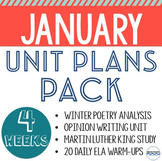Martin Luther King - Reading Comprehension, Activities, Nonfiction MLK Passage
- PDF
What educators are saying
Also included in
- New Year…new set of fun and engaging unit plans! This bundle includes 4 print-and-teach units that you can teach during the entire month of January! That’s right! Just download these units and you won’t have to do a bit of lesson planning! This bundle includes four resources that perfectly pairPrice $22.99Original Price $26.96Save $3.97
Description
This 5-day unit covers many critical ELA skills as students develop a deep understanding and connection to Martin Luther King, Jr.! While studying about King, students practice critical skills including reading comprehension, identifying nonfiction text features, participating in group discussions, analyzing a quote, cooperative learning, and writing. Six activities are included in this unit. Each is based on a nonfiction reading passage about Martin Luther King, Jr. The activities are designed to be interactive, engaging, and educational. This unit is perfect to teach as a celebration of Martin Luther King, Jr. Day or Black History Month, as preparation for standardized assessments, in conjunction with a biography unit, or any time during the year!
About the Activities
- Reading Comprehension - During this lesson, students will practice critical reading comprehension skills as they read a nonfiction text about Martin Luther King, Jr. Then, they will demonstrate their comprehension of the passage by responding to multiple-choice and short answer questions.
- Nonfiction Text Features - In this activity students define and identify nonfiction text features. First, students will match different types of text features with their definitions. Then, they’ll find examples of the text features in the passage about Martin Luther King, Jr. Finally, they’ll put together the type, definitions, and examples into mini-puzzles that they can glue directly into their packets.
- Small Group Discussions - Students will participate in group discussions about the reading passage and Martin Luther King, Jr. in small groups. Before working together in groups, they’ll develop a list that describes the elements of effective groups. Then, they’ll take turns posing questions and responding to them in their groups. Finally, students will reflect on their experiences and learning.
- Martin Luther King, Jr. Facts - Students will learn and share 8 new facts about Martin Luther King, Jr. The lesson with start with each student having a single fact. Then, they’ll need to rotate around the classroom to find a student with a different fact. Next, they’ll switch facts, and continue collecting new facts until they’ve filled in their charts.
- Quote Analysis - Students practice their analysis skills when they work to analyze one of King’s famous quotes. They share their analysis with partners and small groups to dive even deeper into the quote’s meaning.
- Writing - In this activity students will not only share their own dreams, but they’ll build a connection with King by also dreaming about a better, brighter future.
- Art Integration - As an added bonus, Art with Jenny K has provided an art activity where students unscramble and draw a portrait of Martin Luther King, Jr.. This activity is a perfect companion to this unit.
Skills Developed
- Citing textual evidence
- Answering multiple choice and short answer questions
- Identifying nonfiction text features
- Working collaboratively
- Participating effectively in group discussions
- Reflecting on learning
- Analyzing a quote
- Writing and reflecting
CCSS Standards
This detailed unit includes:
- Unit Overview
- 6 Detailed Lesson Plans
- Background Information (for students and/or teachers)
- Nonfiction Text Features Puzzle Pieces – Types, Definitions, Examples
- Group Discussion Questions (12)
- Facts Cards about Martin Luther King, Jr. (8)
- Quote Cards (4)
- All Instructional Keys
- Student Packets:
- --- Informational Passage about MLK (2 pages)
- --- Reading Comprehension Questions – multiple-choice and short answer
- --- Nonfiction Text Features Guided Notes and Puzzle Activity
- --- Group Discussion Brainstorm and Reflection
- --- Martin Luther King Jr. Fact Collection Chart
- --- Quote Analysis Activity
- --- Writing Prompt
Art Integration
Want to take this unit to the next level? Then, add this Martin Luther King Jr Collaboration Portrait Poster created by Art with Jenny K to these lessons. It would work perfectly as an anticipatory set or culminating activity.
Looking for the perfect addition to this unit? Then, just pair this study of MLK with an analysis of his famous speech, "What is Your Life's Blueprint?"
You may also like…
- ”What is Your Life’s Blueprint?” - Speech Analysis Unit
- Malala Yousafzai - Listening Comprehension Unit
Following is Fun!
Get the inside scoop on all store discounts, free products, and product launches. Just click the green “Follow Me” star under my store name on this page or click the green “Follow Me” star on my store homepage.
Let’s Stay in Touch!
*** Click HERE to receive the Brain Waves Instruction Newsletter filled with exclusive FREEBIES and Teaching Tips!
Thanks!
Brain Waves Instruction






